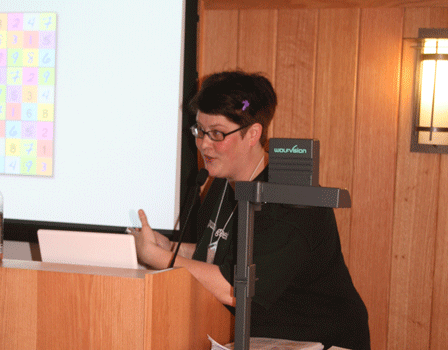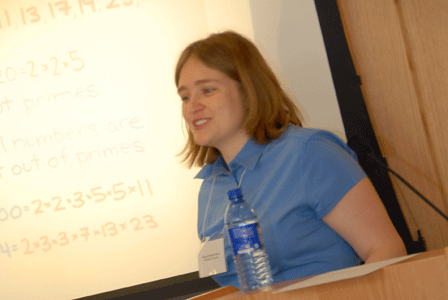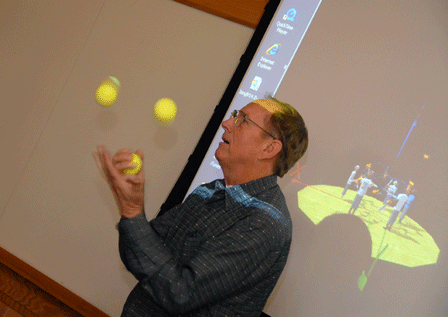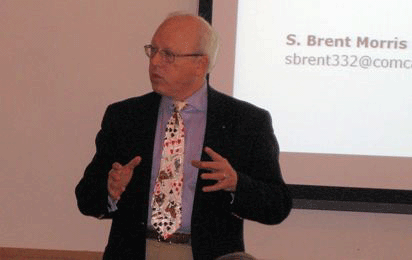- About MAA
- Membership
- MAA Publications
- Periodicals
- Blogs
- MAA Book Series
- MAA Press (an imprint of the AMS)
- MAA Notes
- MAA Reviews
- Mathematical Communication
- Information for Libraries
- Author Resources
- Advertise with MAA
- Meetings
- Competitions
- Programs
- Communities
- MAA Sections
- SIGMAA
- MAA Connect
- Students
- MAA Awards
- Awards Booklets
- Writing Awards
- Teaching Awards
- Service Awards
- Research Awards
- Lecture Awards
- Putnam Competition Individual and Team Winners
- D. E. Shaw Group AMC 8 Awards & Certificates
- Maryam Mirzakhani AMC 10 A Awards & Certificates
- Two Sigma AMC 10 B Awards & Certificates
- Jane Street AMC 12 A Awards & Certificates
- Akamai AMC 12 B Awards & Certificates
- High School Teachers
- News
You are here
Carriage House Opening: A Mathematical Carnival
The MAA celebrated the opening of its Carriage House Conference Center last week with a veritable mathematical carnival. Researchers, educators, students, and others enjoyed presentations that featured juggling, card shuffling, sleight-of-hand, sudoku puzzles, drag racing, lightning-fast calculation, driver's license numbers, sums of squares, and prime numbers.
At Friday's opening, Carl Pomerance, of Dartmouth College, addressed the mysteries of prime numbers in his talk "Prime Time for Primes." He highlighted recent progress in finding a surprising and fast way to distinguish primes from composites and research on gaps between primes that may yet lead to a proof that there are infinitely many twin primes.

Carl Pomerance
Laura Taalman, from James Madison University, looked at sudoku puzzles and their variants in her presentation "Sudoku: Questions, Variations, and Research."

Laura Taalman
Manjul Bhargava, of Princeton University, gave an illuminating talk on "Sums of Squares and the '290-Theorem'." Bhargava announced that he and Jonathan Hanke of Duke University had recently proved the 290 theorem: If an integer-valued quadratic form, such as 3x2 + xy + 5y2 + 6z2 + t2, represents each of 1, 2, 3, 5, 6, 7, 10, 13, 14, 15, 17, 19, 21, 22, 23, 26, 29, 30, 31, 34, 35, 37, 42, 58, 93, 110, 145, 203, and 290, then it represents all positive integers.

Manjul Bhargava
Richard Tapia, from Rice University, concluded the colloquium by looking at "Math at Top Speed: Exploring and Breaking Myths in the Drag Racing Folklore." He described his early interest and experience in drag racing, his brother Bobby's exploits in setting a world record and winning contests against highly touted racers and vehicles, and some simple mathematical modeling that elucidates the factors that lead to improved performance.

Richard Tapia
The following day, at a Math Fair for local high school students and teachers, Harvey Mudd's Arthur Benjamin demonstrated incredible mathematical prestidigitation in his "Mathemagics!" show. He pitted his own mental prowess against students using calculators to compute the squares of three-digit and four-digit numbers—and won every time. Benjamin is co-editor of Math Horizons, author of Secrets of Mental Math, and co-author of the award-winning MAA book Proofs That Really Count.

Art Benjamin
Princeton graduate student Melanie Wood explained the tricky business of exploring "Random Behavior in the Prime Numbers." In 2003, Wood was the first U.S. woman (and second woman overall) to win the Putnam competition—a prestigious math contest for college students. A year later, she received the Morgan Prize for research by an undergraduate.

Melanie Wood Matchett
Ron Graham, from the San Diego campus of the University of California, performed and offered insight into "The Mathematics of Juggling." Noting the disproportionately high number of mathematicians and computer scientists in the juggling community, Graham described how mathematical analyses can lead to novel juggling patterns. Additional information can be found in a chapter that Graham and Joe Buhler, of Reed College, wrote for the MAA book Mathematical Adventures for Students and Amateurs.

Ron Graham
S. Brent Morris, a mathematician who once worked at the National Security Agency, dazzled attendees with his card shuffling dexterity and the mathematics behind "Magic Tricks, Card Shuffling, and Dynamic Computer Memories." Morris is the author of an MAA book with the same title.

S. Brent Morris
In concluding the program, MAA President Joe Gallian, from the University of Minnesota-Duluth, described his quest to break driver's license codes—that is, figure out the formulas that different states use to come up with identification numbers for driver's licenses.

Joe Gallian
The sessions at the Carriage House Conference Center attracted full houses all weekend.
The newly renovated facility itself combines the versatility of a modern meeting space with the charm of the original 1892 structure. The MAA can now host a broad range of mathematical programs, special lectures, research conferences, workshops, and programs for students and the public. Other associations and groups are welcome to reserve, rent, and make use of the building's conference and meeting rooms.
The creation of the Carriage House Conference Center was made possible by a generous donation from Paul and Virginia Halmos. It reflects their lifelong desire to advance the MAA's longstanding tradition of fostering high-quality mathematical exposition. Friday's colloquium, in particular, honored mathematician and benefactor Paul Halmos.—H. Waldman
id:
4229
News Date:
Monday, April 23, 2007
Category:




